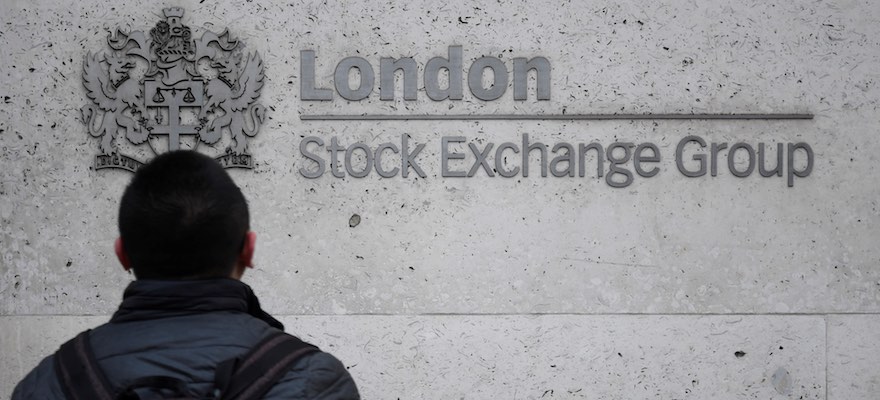Policy makers across the world are acting in ways that suggest there may have been more to last month’s Group of 20 meeting in Shanghai than mere platitudes about promoting global economic growth.
In the past few weeks, officials from China, the euro area, Japan, the U.S. and the U.K. have taken a barrage of actions to keep the world economy afloat and currency markets calm.
That’s led some analysts to conclude that there is indeed a secret Shanghai Accord, akin to those reached in an earlier era at the Plaza Hotel in New York and at the Louvre Museum in Paris. The Federal Reserve on Wednesday capped off the series of moves by global policy makers by forecasting a shallower-than-anticipated rise in interest rates this year, with Chair Janet Yellen stressing the risks from a weaker global outlook and market turbulence.
Behind the suspected agreement, according to Joachim Fels of Pacific Investment Management Co. and David Zervos of Jefferies LLC, is a belief that a further major dollar rise against the euro and the yen would be bad for the global economy.
“There seems to be some kind of tacit Shanghai Accord in place,” said Fels, who is global economic adviser for Pimco, which oversees $1.43 trillion in assets. “The agreement is to roughly stabilize the dollar versus the major currencies through appropriate monetary policy action, not through intervention.”
Many other analysts are skeptical. “I don’t think there is a coordinated agreement among central banks to follow the policies they have,” said Charles Collyns, chief economist for the Institute of International Finance in Washington and a former U.S. Treasury official. “But clearly central banks do talk with each other and are aware of each other’s strategies.”
At the Plaza Hotel in 1985, the U.S. and its four industrial-nation allies struck a deal to bring down the sky-high dollar through concerted selling on the currency market. They came together a year and half later in Paris with the aim of stabilizing the greenback after successfully engineering its decline.
Deal Buzz
In the run-up to the Shanghai meeting of G-20 finance ministers and central bankers in February, the investment world was abuzz with talk that officials would need to adopt a Plaza Accord-type deal to restore order to unruly financial markets and keep the global expansion on track -- speculation that G-20 officials repeatedly denied.
The group ended its meeting on Feb. 27 with a commitment to use all policy tools to strengthen growth. The officials also pledged, for the first time, to consult closely on foreign Exchange
Exchange
An exchange is known as a marketplace that supports the trading of derivatives, commodities, securities, and other financial instruments.Generally, an exchange is accessible through a digital platform or sometimes at a tangible address where investors organize to perform trading. Among the chief responsibilities of an exchange would be to uphold honest and fair-trading practices. These are instrumental in making sure that the distribution of supported security rates on that exchange are effectiv
An exchange is known as a marketplace that supports the trading of derivatives, commodities, securities, and other financial instruments.Generally, an exchange is accessible through a digital platform or sometimes at a tangible address where investors organize to perform trading. Among the chief responsibilities of an exchange would be to uphold honest and fair-trading practices. These are instrumental in making sure that the distribution of supported security rates on that exchange are effectiv
Read this Term rates.
Fels and Zervos argue that behind those words is, in effect, a dollar detente. Their theory goes like this: The European Central Bank and Bank of Japan will make limited use of negative interest rates to boost growth because they tend to cause downward pressure on their respective currencies, and upward pressure on the greenback. Instead, those central banks will focus on increasing domestic credit expansion, through corporate bond purchases or other means.
The Fed, for its part, would dial back its plans to raise interest rates under the presumed pact -- a step that Yellen and her colleagues indeed took this week. The bulk of Fed officials now expects to raise rates just twice this year, instead of the four quarter-point hikes they previously foresaw in December.
By acting to stabilize the dollar, the major central banks ease pressure on China to engineer a significant depreciation of its currency, a result that would be a disaster for the world economy, according to Fels and Zervos.
“The Chinese have probably put on the table that that they will not pursue aggressive devaluation as long as the Fed doesn’t overdo it on interest rates and as long as the dollar doesn’t appreciate too much against the euro and the yen,” Fels said.
Dollar’s Drop
If the goal was to stem the greenback’s rise, policy makers have succeeded: The Bloomberg Dollar Spot Index, which tracks the currency against 10 counterparts, has dropped about 4 percent since the G-20 meeting, after a rise of more than 20 percent since the end of 2013. The yen’s 8 percent gain against the dollar this year, including a 1 percent rise on Thursday following the Fed decision, have helped spur speculation of possible intervention by Japan to stem the currency’s advance.
Edwin Truman, a 25-year veteran of the Fed and Treasury, sees things more prosaically than Fels and Zervos.
Yellen and other policy makers went to Shanghai and heard from the International Monetary Fund, as well as fellow officials, that the global economy wasn’t in good shape. That probably reinforced what they were thinking already. So when when they returned home, they acted accordingly, said Truman, now a senior fellow at the Peterson Institute for International Economics in Washington.
Collyns said there are other reasons besides a so-called accord that would explain why central banks are acting the way they are: The ECB is worried that deeply negative rates would hurt European banks. The BOJ is facing a backlash from savers and others in Japan against its decision in January to push rates below zero. And the Fed wants to keep the U.S. expansion on track.
Spillover Effects
Yellen said at a press briefing Wednesday that the spillover effects of policy moves through exchange rates form linkages that are an “important factor” in designing monetary policy. At the same time, with the U.S. growing more strongly than other nations and still planning to raise interest rates, “it’s natural that there should be some divergence in our monetary policies.”
What may be going on, said former Fed official Peter Hooper, is that policy makers are becoming more aware of the impact their actions can have on other countries and the possible subsequent blowback on their own economies. That’s led to an “appearance” of more coordination, said Hooper, who is now chief economist for Deutsche Bank Securities in New York.
"Maybe there was a meeting in a backroom in which they all agreed to do something," said former IMF chief economist Olivier Blanchard, when asked about the possibility of an accord. "I don’t think so."
"The world looks a bit worse than it used to," continued Blanchard, who is now with the Peterson Institute. "Everybody is reassessing. I really don’t see any grand plan."
--With assistance from Simon Kennedy Enda Curran Paul Gordon and Piotr Skolimowski To contact the reporter on this story: Rich Miller in Washington at rmiller28@bloomberg.net. To contact the editors responsible for this story: Brendan Murray at brmurray@bloomberg.net, Scott Lanman
By: Rich Miller
©2016 Bloomberg News
Policy makers across the world are acting in ways that suggest there may have been more to last month’s Group of 20 meeting in Shanghai than mere platitudes about promoting global economic growth.
In the past few weeks, officials from China, the euro area, Japan, the U.S. and the U.K. have taken a barrage of actions to keep the world economy afloat and currency markets calm.
That’s led some analysts to conclude that there is indeed a secret Shanghai Accord, akin to those reached in an earlier era at the Plaza Hotel in New York and at the Louvre Museum in Paris. The Federal Reserve on Wednesday capped off the series of moves by global policy makers by forecasting a shallower-than-anticipated rise in interest rates this year, with Chair Janet Yellen stressing the risks from a weaker global outlook and market turbulence.
Behind the suspected agreement, according to Joachim Fels of Pacific Investment Management Co. and David Zervos of Jefferies LLC, is a belief that a further major dollar rise against the euro and the yen would be bad for the global economy.
“There seems to be some kind of tacit Shanghai Accord in place,” said Fels, who is global economic adviser for Pimco, which oversees $1.43 trillion in assets. “The agreement is to roughly stabilize the dollar versus the major currencies through appropriate monetary policy action, not through intervention.”
Many other analysts are skeptical. “I don’t think there is a coordinated agreement among central banks to follow the policies they have,” said Charles Collyns, chief economist for the Institute of International Finance in Washington and a former U.S. Treasury official. “But clearly central banks do talk with each other and are aware of each other’s strategies.”
At the Plaza Hotel in 1985, the U.S. and its four industrial-nation allies struck a deal to bring down the sky-high dollar through concerted selling on the currency market. They came together a year and half later in Paris with the aim of stabilizing the greenback after successfully engineering its decline.
Deal Buzz
In the run-up to the Shanghai meeting of G-20 finance ministers and central bankers in February, the investment world was abuzz with talk that officials would need to adopt a Plaza Accord-type deal to restore order to unruly financial markets and keep the global expansion on track -- speculation that G-20 officials repeatedly denied.
The group ended its meeting on Feb. 27 with a commitment to use all policy tools to strengthen growth. The officials also pledged, for the first time, to consult closely on foreign Exchange
Exchange
An exchange is known as a marketplace that supports the trading of derivatives, commodities, securities, and other financial instruments.Generally, an exchange is accessible through a digital platform or sometimes at a tangible address where investors organize to perform trading. Among the chief responsibilities of an exchange would be to uphold honest and fair-trading practices. These are instrumental in making sure that the distribution of supported security rates on that exchange are effectiv
An exchange is known as a marketplace that supports the trading of derivatives, commodities, securities, and other financial instruments.Generally, an exchange is accessible through a digital platform or sometimes at a tangible address where investors organize to perform trading. Among the chief responsibilities of an exchange would be to uphold honest and fair-trading practices. These are instrumental in making sure that the distribution of supported security rates on that exchange are effectiv
Read this Term rates.
Fels and Zervos argue that behind those words is, in effect, a dollar detente. Their theory goes like this: The European Central Bank and Bank of Japan will make limited use of negative interest rates to boost growth because they tend to cause downward pressure on their respective currencies, and upward pressure on the greenback. Instead, those central banks will focus on increasing domestic credit expansion, through corporate bond purchases or other means.
The Fed, for its part, would dial back its plans to raise interest rates under the presumed pact -- a step that Yellen and her colleagues indeed took this week. The bulk of Fed officials now expects to raise rates just twice this year, instead of the four quarter-point hikes they previously foresaw in December.
By acting to stabilize the dollar, the major central banks ease pressure on China to engineer a significant depreciation of its currency, a result that would be a disaster for the world economy, according to Fels and Zervos.
“The Chinese have probably put on the table that that they will not pursue aggressive devaluation as long as the Fed doesn’t overdo it on interest rates and as long as the dollar doesn’t appreciate too much against the euro and the yen,” Fels said.
Dollar’s Drop
If the goal was to stem the greenback’s rise, policy makers have succeeded: The Bloomberg Dollar Spot Index, which tracks the currency against 10 counterparts, has dropped about 4 percent since the G-20 meeting, after a rise of more than 20 percent since the end of 2013. The yen’s 8 percent gain against the dollar this year, including a 1 percent rise on Thursday following the Fed decision, have helped spur speculation of possible intervention by Japan to stem the currency’s advance.
Edwin Truman, a 25-year veteran of the Fed and Treasury, sees things more prosaically than Fels and Zervos.
Yellen and other policy makers went to Shanghai and heard from the International Monetary Fund, as well as fellow officials, that the global economy wasn’t in good shape. That probably reinforced what they were thinking already. So when when they returned home, they acted accordingly, said Truman, now a senior fellow at the Peterson Institute for International Economics in Washington.
Collyns said there are other reasons besides a so-called accord that would explain why central banks are acting the way they are: The ECB is worried that deeply negative rates would hurt European banks. The BOJ is facing a backlash from savers and others in Japan against its decision in January to push rates below zero. And the Fed wants to keep the U.S. expansion on track.
Spillover Effects
Yellen said at a press briefing Wednesday that the spillover effects of policy moves through exchange rates form linkages that are an “important factor” in designing monetary policy. At the same time, with the U.S. growing more strongly than other nations and still planning to raise interest rates, “it’s natural that there should be some divergence in our monetary policies.”
What may be going on, said former Fed official Peter Hooper, is that policy makers are becoming more aware of the impact their actions can have on other countries and the possible subsequent blowback on their own economies. That’s led to an “appearance” of more coordination, said Hooper, who is now chief economist for Deutsche Bank Securities in New York.
"Maybe there was a meeting in a backroom in which they all agreed to do something," said former IMF chief economist Olivier Blanchard, when asked about the possibility of an accord. "I don’t think so."
"The world looks a bit worse than it used to," continued Blanchard, who is now with the Peterson Institute. "Everybody is reassessing. I really don’t see any grand plan."
--With assistance from Simon Kennedy Enda Curran Paul Gordon and Piotr Skolimowski To contact the reporter on this story: Rich Miller in Washington at rmiller28@bloomberg.net. To contact the editors responsible for this story: Brendan Murray at brmurray@bloomberg.net, Scott Lanman
By: Rich Miller
©2016 Bloomberg News















